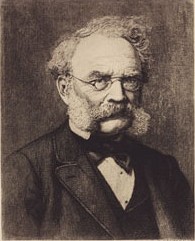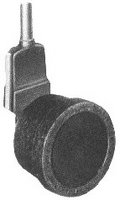
The word "dynamic" simply refers to the role of motion in the device. the word is poorly chosen simce many microphones function involves motion. But more specificly "dynamic" always refers to a moving-coil device. This usually refers to Plunger coil microphones but technically ribbon mics are also Dynamic mics. (more later)
The dynamic microphone was invented in 1877 twice. Once by Curttris and Redding working together in the United States and also by Ernst W. Siemens (pictured) working alone in Germany. It was , Siemens who obtained the patent on Jan. 20, 1874, and was granted patent No. 149,797 Apr. 14, 1874.
Both the American and German designs consisted of a small, light-weight, electrically-conducting coil of wire mechanically attached to the frustum of a light-weight, cone-shaped diaphragm that vibrated in sympathy with sound waves propagating through air. If the coil is moved by a diaphram, a voltage is induced in the coil. If a current flows through the coil, forces are exerted that cause the coil to move. The  dynamic microphone has a lower noise or distortion level than that of the carbon microphone and required no power to operate.
dynamic microphone has a lower noise or distortion level than that of the carbon microphone and required no power to operate.
But those were not usable mics. The first practical commercial dynamic microphone was the Western Electric 618-A introduced in the late 1920's. It was developed by Thuras and Wente at Bell Labs.
For the record, Siemens was considered the greatest inventor of his era. In 1879, Siemens demonstrated the first electric railway at the Berlin Trade Fair. Two years later the electric tramway near Berlin was built. His name is used as the unit of electrical conductance, the siemens.




No comments:
Post a Comment